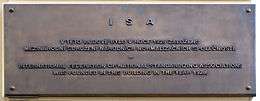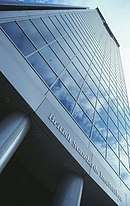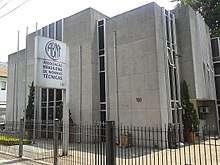Standards organization
A standards organization, standards body, standards developing organization (SDO), or standards setting organization (SSO) is an organization whose primary activities are developing, coordinating, promulgating, revising, amending, reissuing, interpreting, or otherwise producing technical standards[1] that are intended to address the needs of a group of affected adopters.
Most standards are voluntary in the sense that they are offered for adoption by people or industry without being mandated in law. Some standards become mandatory when they are adopted by regulators as legal requirements in particular domains.
The term formal standard refers specifically to a specification that has been approved by a standards setting organization. The term de jure standard refers to a standard mandated by legal requirements or refers generally to any formal standard. In contrast, the term de facto standard refers to a specification (or protocol or technology) that has achieved widespread use and acceptance – often without being approved by any standards organization (or receiving such approval only after it already has achieved widespread use). Examples of de facto standards that were not approved by any standards organizations (or at least not approved until after they were in widespread de facto use) include the Hayes command set developed by Hayes, Apple's TrueType font design and the PCL protocol used by Hewlett-Packard in the computer printers they produced.
Normally, the term standards organization is not used to refer to the individual parties participating within the standards developing organization in the capacity of founders, benefactors, stakeholders, members or contributors, who themselves may function as the standards organizations.
History
Standardization

The implementation of standards in industry and commerce became highly important with the onset of the Industrial Revolution and the need for high-precision machine tools and interchangeable parts. Henry Maudslay developed the first industrially practical screw-cutting lathe in 1800, which allowed for the standardization of screw thread sizes for the first time.[1]
Maudslay's work, as well as the contributions of other engineers, accomplished a modest amount of industry standardization; some companies' in-house standards spread a bit within their industries. Joseph Whitworth's screw thread measurements were adopted as the first (unofficial) national standard by companies around the country in 1841. It came to be known as the British Standard Whitworth, and was widely adopted in other countries.[2][3]
Early standards organizations
By the end of the 19th century differences in standards between companies was making trade increasingly difficult and strained. For instance, an iron and steel dealer recorded his displeasure in The Times: "Architects and engineers generally specify such unnecessarily diverse types of sectional material or given work that anything like economical and continuous manufacture becomes impossible. In this country no two professional men are agreed upon the size and weight of a girder to employ for given work".
The Engineering Standards Committee was established in London in 1901 as the world's first national standards body.[4][5] It subsequently extended its standardization work and became the British Engineering Standards Association in 1918, adopting the name British Standards Institution in 1931 after receiving its Royal Charter in 1929. The national standards were adopted universally throughout the country, and enabled the markets to act more rationally and efficiently, with an increased level of cooperation.
After the First World War, similar national bodies were established in other countries. The Deutsches Institut für Normung was set up in Germany in 1917, followed by its counterparts, the American National Standard Institute and the French Commission Permanente de Standardisation, both in 1918.[1]
International organizations
Several international organizations create international standards, such as Codex Alimentarius in food, the World Health Organization Guidelines in health, or ITU Recommendations in ICT[6] and being publicly funded, are freely available for consideration and use worldwide.
International standards associations
In 1904, Crompton represented Britain at the Louisiana Purchase Exposition in St. Louis, Missouri, as part of a delegation by the Institute of Electrical Engineers. He presented a paper on standardization, which was so well received that he was asked to look into the formation of a commission to oversee the process. By 1906 his work was complete and he drew up a permanent terms for the International Electrotechnical Commission.[7] The body held its first meeting that year in London, with representatives from 14 countries. In honour of his contribution to electrical standardization, Lord Kelvin was elected as the body's first President.[8]

The International Federation of the National Standardizing Associations (ISA) was founded in 1926 with a broader remit to enhance international cooperation for all technical standards and specifications. The body was suspended in 1942 during World War II.
After the war, ISA was approached by the recently formed United Nations Standards Coordinating Committee (UNSCC) with a proposal to form a new global standards body. In October 1946, ISA and UNSCC delegates from 25 countries met in London and agreed to join forces to create the new International Organization for Standardization (ISO); the new organization officially began operations in February 1947.[9]
Overview
Standards organizations can be classified by their role, position, and the extent of their influence on the local, national, regional, and global standardization arena.
By geographic designation, there are international, regional, and national standards bodies (the latter often referred to as NSBs). By technology or industry designation, there are standards developing organizations (SDOs) and also standards setting organizations (SSOs) also known as consortia. Standards organizations may be governmental, quasi-governmental or non-governmental entities. Quasi- and non-governmental standards organizations are often non-profit organizations.
International standards organizations

Broadly, an international standards organization develops international standards. (This does not necessarily restrict the use of other published standards internationally.)
There are many international standards organizations. The three largest and most well-established such organizations are the International Organization for Standardization, the International Electrotechnical Commission, and the International Telecommunication Union, which have each existed for more than 50 years (founded in 1947, 1906, and 1865, respectively) and are all based in Geneva, Switzerland. They have established tens of thousands of standards covering almost every conceivable topic. Many of these are then adopted worldwide replacing various incompatible "homegrown" standards. Many of these standards are naturally evolved from those designed in-house within an industry, or by a particular country, while others have been built from scratch by groups of experts who sit on various technical committees (TCs). These three organizations together comprise the World Standards Cooperation (WSC) alliance.
ISO is composed of the national standards bodies (NSBs), one per member economy. The IEC is similarly composed of national committees, one per member economy. In some cases, the national committee to the IEC of an economy may also be the ISO member from that country or economy. ISO and IEC are private international organizations that are not established by any international treaty. Their members may be non-governmental organizations or governmental agencies, as selected by ISO and IEC (which are privately established organizations).
The ITU is a treaty-based organization established as a permanent agency of the United Nations, in which governments are the primary members, although other organizations (such as non-governmental organizations and individual companies) can also hold a form of direct membership status in the ITU as well. Another example of a treaty-based international standards organization with government membership is the Codex Alimentarius Commission.

In addition to these, a large variety of independent international standards organizations such as the ASME, the ASTM International, the IEEE, the Internet Engineering Task Force (IETF), SAE International, TAPPI, the World Wide Web Consortium (W3C), and the Universal Postal Union (UPU) develop and publish standards for a variety of international uses. In many such cases, these international standards organizations are not based on the principle of one member per country. Rather, membership in such organizations is open to those interested in joining and willing to agree to the organization's by-laws – having either organizational/corporate or individual technical experts as members.
The Airlines Electronic Engineering Committee (AEEC) was formed in 1949 to prepare avionics system engineering standards with other aviation organizations RTCA, EUROCAE, and ICAO. The standards are widely known as the ARINC Standards.
Regional standards organizations
Regional standards bodies also exist, such as the European Committee for Standardization (CEN), the European Committee for Electrotechnical Standardization (CENELEC), the European Telecommunications Standards Institute (ETSI), and the Institute for Reference Materials and Measurements (IRMM) in Europe, the Pacific Area Standards Congress (PASC), the Pan American Standards Commission (COPANT), the African Organisation for Standardisation (ARSO), the Arabic industrial development and mining organization (AIDMO), and others.
In the European Union, only standards created by CEN, CENELEC, and ETSI are recognized as European standards (according to Regulation (EU) No 1025/2012[10]), and member states are required to notify the European Commission and each other about all the draft technical regulations concerning ICT products and services before they are adopted in national law.[11] These rules were laid down in Directive 98/34/EC with the goal of providing transparency and control with regard to technical regulations.[11]
Sub-regional standards organizations also exist such as the MERCOSUR Standardization Association (AMN), the CARICOM Regional Organisation for Standards and Quality (CROSQ), and the ASEAN Consultative Committee for Standards and Quality (ACCSQ), EAC East Africa Standards Committee www.eac-quality.net, and the GCC Standardization Organization (GSO) for Arab States of the Persian Gulf.
National standards bodies
In general, each country or economy has a single recognized national standards body (NSB). A national standards body is likely the sole member from that economy in ISO; ISO currently has 161 members. National standards bodies usually do not prepare the technical content of standards, which instead is developed by national technical societies.
| Organization | Initials | Country |
|---|---|---|
| Bulgarian Institute for Standardization (The Bulgarian Institute for Standardization (BDS)) (https://www.bds-bg.org/en), Българският институт за стандартизация (БИС or БДС), is the national executive body for standardization in the Republic of Bulgaria). See also the Bulgarian Academy of Sciences (BAS), Българската академия на науките (БАН) (http://www.bas.bg/en)) | BDS (БДС which means Bulgarian State Standard), or rarely as BIS (БИС) (BIzS/BIfS/BulIfS) following the Bulgarian naming (i.e. Българският институт за стандартизация (БИС)) | Bulgaria |
| Bureau of Indian Standards | BIS | India |
| Bangladesh Standards and Testing Institution | BSTI | Bangladesh |
| Badan Standardisasi Nasional | BSN | Indonesia |
| Brazilian National Standards Organization | ABNT | Brazil |
| Spanish Association for Standardization and Certification | AENOR | Spain |
| French association for Standardization | AFNOR | France |
| American National Standards Institute | ANSI | U.S. |
| Romanian Standards Association | ASRO | Romania |
| British Standards Institution | BSI | U.K. |
| Dirección General de Normas | DGN | Mexico |
| Deutsches Institut für Normung | DIN | Germany |
| Instituto Argentino de Normalización y Certificación | IRAM | Argentina |
| Bureau of Standards of Jamaica | BSJ | Jamaica |
| Euro-Asian Council for Standardization, Metrology and Certification | GOST | Russia (Soviet Union) |
| Colombian Institute of Technical Standards and Certification | ICONTEC | Colombia |
| Luxembourg Institute for Standardization, Accreditation, Security, and Quality of Products and Services | ILNAS | Luxembourg |
| Japanese Industrial Standards Committee | JISC | Japan |
| Korean Agency for Technology and Standards | KATS | Korea (Republic) |
| Hungarian Standards Institution | MSZT | Hungary |
| Norme Belge-Belgische Norm | NBN | Belgium |
| Nederlandse Norm | NEN | Netherlands |
| South African Bureau of Standards | SABS | South Africa |
| Standardization Administration of China | SAC | China |
| Standards Council of Canada | SCC | Canada |
| Standards Organisation of Nigeria | SON | Nigeria |
| Swedish Standards Institute | SIS | Sweden |
| Finnish Standards Association | SFS | Finland |
| Standards Norway | SN | Norway |
| Estonian Centre for Standardisation | EVS | Estonia |
| Swiss Association for Standardization | SNV | Switzerland |
| Standards New Zealand | SNZ | New Zealand |
| Turkish Standards Institution | TSE | Turkey |
| Ente Nazionale Italiano di Unificazione | UNI | Italy |
| Standards Australia | SAI | Australia |
| Jabatan Standard Malaysia | DSM | Malaysia |
| Instituto Português da Qualidade | IPQ | Portugal |
NSBs may be either public or private sector organizations, or combinations of the two. For example, the Standards Council of Canada is a Canadian Crown Corporation, Dirección General de Normas is a governmental agency within the Mexican Ministry of Economy, and ANSI is a 501(c)(3) non-profit U.S. organization with members from both the private and public sectors. The National Institute of Standards and Technology (NIST), the U.S. government's standards agency, cooperates with ANSI under a memorandum of understanding to collaborate on the United States Standards Strategy. The determinates of whether an NSB for a particular economy is a public or private sector body may include the historical and traditional roles that the private sector fills in public affairs in that economy or the development stage of that economy.
Standards developing organizations (SDOs)
Whereas, the term national standards body (NSB) generally refers to the one-per-country standardization organization that is that country’s member of the ISO, the term standards developing organization (SDO) generally refers to the thousands of industry- or sector-based standards organizations that develop and publish industry specific standards. Some economies feature only an NSB with no other SDOs. Large economies like the United States and Japan have several hundred SDOs, many of which are coordinated by the central NSBs of each country (ANSI and JISC in this case). In some cases, international industry-based SDOs such as the IEEE and the Audio Engineering Society (AES) may have direct liaisons with international standards organizations, having input to international standards without going through a national standards body. SDOs are differentiated from standards setting organizations (SSOs) in that SDOs may be accredited to develop standards using open and transparent processes.
Scope of work
Developers of technical standards are generally concerned with interface standards, which detail how products interconnect with each other, and safety standards, which established characteristics ensure that a product or process is safe for humans, animals, and the environment. The subject of their work can be narrow or broad. Another area of interest is in defining how the behavior and performance of products is measured and described in data sheets.
Overlapping or competing standards bodies tend to cooperate purposefully, by seeking to define boundaries between the scope of their work, and by operating in a hierarchical fashion in terms of national, regional and international scope; international organizations tend to have as members national organizations; and standards emerging at national level (such as BS 5750) can be adopted at regional levels (BS 5750 was adopted as EN 29000) and at international levels (BS 5750 was adopted as ISO 9000).
Unless adopted by a government, standards carry no force in law. However, most jurisdictions have truth in advertising laws, and ambiguities can be reduced if a company offers a product that is "compliant" with a standard.
Standards development process
When an organization develops standards that may be used openly, it is common to have formal rules published regarding the process. This may include:
- Who is allowed to vote and provide input on new or revised standards
- What is the formal step-by-step process
- How are bias and commercial interests handled
- How negative votes or ballots are handled
- What type of consensus is required
Though it can be a tedious and lengthy process, formal standard setting is essential to developing new technologies. For example, since 1865, the telecommunications industry has depended on the ITU to establish the telecommunications standards that have been adopted worldwide. The ITU has created numerous telecommunications standards including telegraph specifications, allocation of telephone numbers, interference protection, and protocols for a variety of communications technologies. The standards that are created through standards organizations lead to improved product quality, ensured interoperability of competitors’ products, and they provide a technological baseline for future research and product development. Formal standard setting through standards organizations has numerous benefits for consumers including increased innovation, multiple market participants, reduced production costs, and the efficiency effects of product interchangeability.
Standards distribution and copyright
Some standards – such as the SIF Specification in K12 education – are managed by a non-profit organizations composed of public entities and private entities working in cooperation that then publish the standards under an open license at no charge and requiring no registration.
A technical library at a university may have copies of technical standards on hand. Major libraries in large cities may also have access to many technical standards.
Some users of standards mistakenly assume that all standards are in the public domain. This assumption is correct only for standards produced by the central governments whose publications are not amenable to copyright or to organizations that issue their standard under an open license. Any standards produced by non-governmental entities remain the intellectual property of their developers (unless specifically designed otherwise) and are protected, just like any other publications, by copyright laws and international treaties. However, the intellectual property extends only to the standard itself and not to its use. For instance if a company sells a device that is compliant with a given standard, it is not liable for further payment to the standards organization except in the special case when the organization holds patent rights or some other ownership of the intellectual property described in the standard.
It is, however, liable for any patent infringement by its implementation, just as with any other implementation of technology. The standards organizations give no guarantees that patents relevant to a given standard have been identified. ISO standards draw attention to this in the foreword with a statement like the following: "Attention is drawn to the possibility that some of the elements of this document may be the subject of patent rights. ISO and IEC shall not be held responsible for identifying any or all such patent rights".[13] If the standards organization is aware that parts of a given standard fall under patent protection, it will often require the patent holder to agree to Reasonable and non-discriminatory licensing before including it in the standard. Such an agreement is regarded as a legally binding contract,[14] as in the 2012 case Microsoft v. Motorola.
Trends
The ever-quickening pace of technology evolution is now more than ever affecting the way new standards are proposed, developed and implemented.
Since traditional, widely respected standards organizations tend to operate at a slower pace than technology evolves, many standards they develop are becoming less relevant because of the inability of their developers to keep abreast with the technological innovation. As a result, a new class of standards setters appeared on the standardization arena: the industry consortia or standards setting organizations (SSOs). Despite having limited financial resources, some of them enjoy truly international acceptance. One example is the World Wide Web Consortium (W3C), whose standards for HTML, CSS, and XML are used universally. There are also community-driven associations such as the Internet Engineering Task Force (IETF), a worldwide network of volunteers who collaborate to set standards for lower-level software solutions.
Some industry-driven standards development efforts don't even have a formal organizational structure. They are projects funded by large corporations. Among them are the OpenOffice.org, an Apache Software Foundation-sponsored international community of volunteers working on an open-standard software that aims to compete with Microsoft Office, and two commercial groups competing fiercely with each other to develop an industry-wide standard for high-density optical storage.
See also
References
- Wang Ping (April 2011), A Brief History of Standards and Standardization Organizations: A Chinese Perspective (PDF), East–West Center
- Gilbert, K. R., & Galloway, D. F., 1978, "Machine Tools". In Charles Singer, et al., (Eds.), A History of Technology. Oxford, Clarendon Press
- Lee, Sidney (Ed.), 1900, Dictionary of National Biography, Vol LXI. Smith Elder, London
- "BSI Group Annual Report and Financial Statements 2010, p. 2" (PDF). Retrieved 3 April 2012.
- Robert C. McWilliam. BSI: The First Hundred Years. 1901–2001. A Century of Achievement. 2001. Thanet Press. London
- "WHO | WHO guidelines approved by the Guidelines Review Committee". WHO. Retrieved 21 August 2019.
- Chris K. Dyer; Patrick T. Moseley; Zempachi Ogumi; David A. J. Rand; Bruno Scrosati Newnes (2010). Encyclopedia of Electrochemical Power Sources. p. 540.
- IEC. "1906 Preliminary Meeting Report, pp. 46–48" (PDF). The minutes from our first meeting. Retrieved 21 October 2012.
- Friendship among equals - Recollections from ISO's first fifty years (PDF), International Organization for Standardization, 1997, pp. 15–18, ISBN 92-67-10260-5, retrieved 26 December 2013
- Regulation (EU) No 1025/2012 of the European Parliament and of the Council of 25 October 2012 on European standardization, amending Council Directives 89/686/EEC and 93/15/EEC and Directives 94/9/EC, 94/25/EC, 95/16/EC, 97/23/EC, 98/34/EC, 2004/22/EC, 2007/23/EC, 2009/23/EC and 2009/105/EC of the European Parliament and of the Council and repealing Council Decision 87/95/EEC and Decision No 1673/2006/EC of the European Parliament and of the Council Text with EEA relevance, 14 November 2012, retrieved 10 January 2019
- European Union: Directive 98/34/EC of the European Parliament and of the Council of 22 June 1998 laying down a procedure for the provision of information in the field of technical standards and regulations Official Journal L é04, 21.7.1998, p. 37–48. (This page also provides references to amendments.) See also European Commission: Enterprise Directorate-General: Vademecum on European Standardisation. (This document contains a consolidated version of Directive 98/34/EC, dated 15 November 2003.) Accessed 2009-05-05.
- ISO Members, retrieved 2012 Feb 21
- Quoted from ISO/IEC 24751-1:2008: Information technology – Individualized adaptability and accessibility in e-learning, education and training – Part 1: Framework and reference model, p. v.
- J. Gregory Sidak (2013). "The Meaning of FRAND, Part I: Royalties". Criterion Economics, Inc.
External links
| Wikimedia Commons has media related to Standards organizations. |